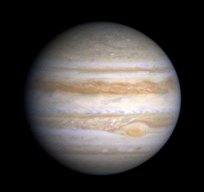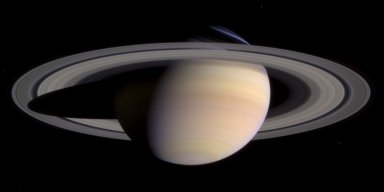

|
Astronomy 161:
An Introduction to Solar System Astronomy
Prof. Richard Pogge, MTWThF 2:30
|
Lecture 37: The Gas Giants:
Jupiter & Saturn


Images from the Cassini Spacecraft [NASA/JPL]
Key Ideas:
Jupiter & Saturn are the largest Planets
Cloud Features:
- Colored Belts & Zones
- Strong Cyclonic Storms
Atmosphere & Internal Structure:
- Thick Hydrogen & Helium Atmospheres
- Radiate more energy than they get from the Sun
- Rocky cores & deep metallic Hydrogen mantles
Jupiter at a Glance
- Orbital Data
- Semi-Major Axis: a = 5.2 AU
- Orbital Period: P = 11.9 years
- Eccentricity: e = 0.048
- Inclination: i = 1.3°
- Planetary Data
- Equatorial Radius: R = 71,492 km (11.21 REarth)
- Mass: M = 317.7 MEarth
- Rotation Period: 9h 50m
- Axis Tilt: 3.1°
- 63 Moons & a faint ring system
Spacecraft to Jupiter
Fly-bys:
- Pioneer 10 & 11 (1973 & 1974)
- Voyager 1 & 2 (1979)
- Ulysses (1992)
- Cassini (2001), enroute to Saturn
Orbiters:
- Galileo (Dec 1995 until Sept 2003)
- Dropped an atmospheric probe in Dec 1995
Saturn at a Glance
- Orbital Data:
- Semi-Major Axis: a = 9.5 AU
- Orbital Period: P = 29.5 years
- Eccentricity: e = 0.056
- Inclination: i = 2.5°
- Planetary Data:
- Equatorial Radius: R = 60,268 km (9.44 REarth)
- Mass: M = 95.2 MEarth
- Rotation Period: 10h 14m
- Axis Tilt: 26.7°
- 60 Moons & a spectacular ring system
Spacecraft Visits to Saturn
Fly-bys:
- Pioneer 11 (Sept 1979)
- Voyager 1 (Nov 1980)
- Voyager 2 (Aug 1981)
Orbiters:
- Cassini (launched Oct 1997, went into orbit July 2004)
- Huygens Titan probe carried by Cassini. Safely landed on
Titan in January 2005
Jupiter & Saturn are Gas Giants
Have no solid surface:
- Deep, heavy hydrogen/helium atmosphere
- Rock & ice core
Rotate rapidly as measured from their magnetic fields:
- Jupiter Rotates once every 9h 50m
- Saturn Rotates once every 10h 14m
This rapid rotation noticably flattens the planets at the poles:
- Jupiter: 6.5% flattening
- Saturn: 10% flattening
Composition
The main constituents of the atmospheres of Jupiter
and Saturn are:
| | Jupiter | | Saturn |
| Hydrogen (H2) |
86% | | >93% |
| Helium (He) |
14% | | >5% |
| Methane (CH4) |
0.1% | | 0.2% |
| Water Vapor (H2O) |
0.1% | | 0.1% |
| Ammonia (NH3) |
0.02% | | 0.01% |
These are examples of Reducing Atmospheres, which
are atmospheres dominated by
Hydrogen Chemistry (CH4, H2O, NH3).
By comparison, Terrestrial planets Oxidizing Atmospheres,
dominated by Oxygen chemistry (CO2, H2O,
N2).
The Clouds of Jupiter
What we see as the "surface" of Jupiter are the tops of the clouds:
- Crystals of ammonia, methane, & water ices
- Average temperature is 100-140 K
The atmosphere of Jupiter is divided into East-West latitudinal bands:
There are also Cyclonic storms that appear in the regions between
Belts and Zones.
Belts & Zones
Belts: high pressure, high temperature
- Gaps in the higher clouds (belts), looking into darker,
slightly warmer & chemically more complex regions
below.
- Colors due to complex organics & polysulfides.
Zones: low pressure, low temperature
- Regions of cold, high ice clouds
- Lighter in color due to a lack of complex organics &
polysulfides
Cyclonic Storms
Get strong winds at the belt/zone boundaries:
- Wind speeds are up to 400 km/hr (compare to a hurricane
at 120 km/hr)
- Winds blow either east-to-west or west-to-east,
alternating between belts/zones.
Results in strong cyclonic storms:
- Get both low-pressure systems (cyclonic) and
high-pressure systems (anticyclonic).
- Range in size up to ~3 Earth diameters!
The Great Red Spot
Largest and most complex of Jupiter's storms:
- Immense high-pressure system more than 40,000 km across
(3 earth diameters)
- Outer parts take about 4-6 days to rotate once
counterclockwise (anticyclonic)
- Varies in strength over time, sometimes deep red, other
times nearly fading out.
- It was first seen in 1665 (>300 years ago!)
- May be a persistent atmospheric instability.
The Atmosphere of Saturn
The atmosphere of Saturn is also divided into dark bands & bright
zones like Jupiter's atmosphere, but...
- Saturn is farther from the Sun, and colder.
- Makes the bands less chemically complex, and so more
subtle & less colorful than Jupiter's.
- West-to-East winds are very strong, up to ~1800 km/hr,
faster than on any other planet.
- Fewer and shorter-lived cyclonic storms.
- Occasional very powerful storms are seen.
Internal Energy
Jupiter and Saturn radiate more energy at Infrared wavelengths than they
receive from the Sun.
Energy Source:
- They are slowly contracting under their own weight.
- Slow gravitational contraction releases gravitational energy,
heating the deep interior.
This internal heat helps power the weather seen on Jupiter
and Saturn.
By contrast, the weather on the Earth, Venus, and Mars is powered by
solar energy (internal "geothermal" heat is insignificant compared to
sunlight).
Interior of the Gas Giants
Atmosphere gets thicker the deeper you go, and the pressure
rises dramatically:
- Just below the clouds, get mushy, hot liquid hydrogen region.
- Very deep, a pressures above 4 Million atmospheres, get region of
liquid metallic hydrogen (protons swimming in a
sea of free electrons)
- Circulation currents in the metallic hydrogen regions generate
huge magnetic fields.
At the bottom is a massive rock & ice core of 10-15 MEarth
& ~1.5 REarth.
Magnetic Fields
Circulating currents in the electrically conductive metallic
hydrogen "mantles" of Jupiter & Saturn generates powerful
magnetic fields:
- Jupiter has the strongest planetary magnetic field in the Solar System.
Magnetic field co-rotates with the interior of the planet
- How we measure the rotation speed of the gas planets
- Winds in the upper atmospheres make it hard to measure the rotation
rate from watching clound features.
Rotating magnetic field also generates radio-wavelength emission
- Jupiter is one of the brightest radio sources in the sky
Saturn vs. Jupiter
Saturn is different from Jupiter in a number of important ways:
- Saturn is less dense (0.7 g/cc, less than the density of water!)
- Saturn has more rotational flattening at the poles (~10%) because
of its lower density.
- Saturn has a smaller metallic hydrogen mantle because its lower
overall mass means lower internal pressures.
- Saturn has less surface Helium than Jupiter (~1/4), probably due
to "rainout" in the deep interior.
Return to [
Unit 6 Index
|
Astronomy 161 Main Page
]
Updated: 2007 November 10
Copyright © Richard W. Pogge,
All Rights Reserved.

